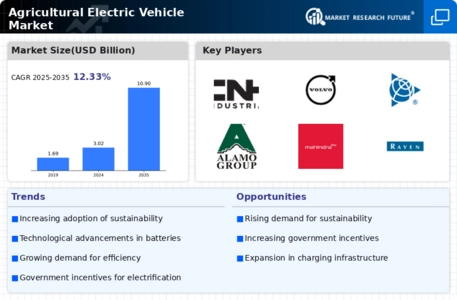Market Growth Projections
The Global Agricultural Electric Vehicle Market Industry is projected to experience robust growth over the coming years. With an anticipated market size of 3.02 USD Billion in 2024, the industry is expected to expand significantly, reaching 10.9 USD Billion by 2035. This growth trajectory indicates a compound annual growth rate of 12.33% from 2025 to 2035, reflecting increasing adoption rates of electric vehicles in agriculture. Factors such as government incentives, technological advancements, and rising fuel costs are expected to contribute to this upward trend. The market's expansion signifies a transformative shift towards sustainable and efficient agricultural practices.
Government Incentives and Support
Governments worldwide are actively promoting the adoption of electric vehicles in agriculture through various incentives and support programs. These initiatives include tax rebates, grants, and subsidies aimed at reducing the initial costs associated with purchasing electric agricultural vehicles. Such measures are crucial in the Global Agricultural Electric Vehicle Market Industry, as they encourage farmers to transition from traditional diesel-powered machinery to electric alternatives. The financial assistance provided by governments is expected to stimulate market growth, contributing to an anticipated market size of 10.9 USD Billion by 2035. This support not only aids farmers financially but also aligns with national goals for reducing greenhouse gas emissions.
Rising Fuel Costs and Economic Viability
The escalating costs of fossil fuels are driving farmers to seek more economically viable alternatives, thereby boosting the Global Agricultural Electric Vehicle Market Industry. As fuel prices continue to rise, the operational cost advantages of electric vehicles become increasingly apparent. Electric tractors and machinery offer lower running costs, which can significantly enhance profitability for farmers. This economic incentive is likely to accelerate the transition to electric vehicles, as farmers aim to mitigate the impact of fluctuating fuel prices on their operations. Consequently, the market is poised for substantial growth as more agricultural stakeholders recognize the financial benefits of adopting electric technologies.
Growing Awareness of Health and Safety Benefits
The Global Agricultural Electric Vehicle Market Industry is also benefiting from a heightened awareness of health and safety benefits associated with electric vehicles. Electric machinery produces less noise and eliminates harmful emissions, creating a safer working environment for farmworkers. This aspect is particularly relevant in regions where agricultural operations are in close proximity to residential areas. As farmers prioritize the health and safety of their workforce, the demand for electric agricultural vehicles is likely to increase. This trend not only enhances the quality of life for farmworkers but also aligns with broader public health objectives, further driving the market's expansion.
Technological Advancements in Electric Vehicles
The Global Agricultural Electric Vehicle Market Industry is significantly influenced by rapid technological advancements in electric vehicle design and functionality. Innovations such as improved battery efficiency, enhanced charging infrastructure, and advanced automation systems are making electric agricultural vehicles more appealing to farmers. These developments are likely to increase the operational range and reduce downtime, addressing previous concerns regarding electric vehicle performance in agriculture. As technology continues to evolve, it is expected that the market will witness a compound annual growth rate of 12.33% from 2025 to 2035, further solidifying the role of electric vehicles in modern farming.
Increasing Demand for Sustainable Farming Practices
The Global Agricultural Electric Vehicle Market Industry is experiencing a notable shift towards sustainable farming practices. Farmers are increasingly adopting electric vehicles to reduce their carbon footprint and comply with environmental regulations. This trend is driven by the growing awareness of climate change and the need for eco-friendly farming solutions. As a result, the market is projected to reach 3.02 USD Billion in 2024, reflecting a significant increase in the adoption of electric tractors and other agricultural machinery. The emphasis on sustainability is likely to propel the market further as more farmers seek to enhance their operational efficiency while minimizing environmental impact.






















